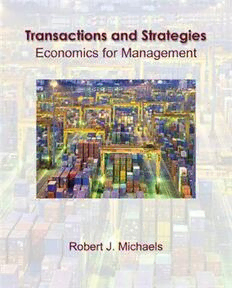
Transactions and Strategies: economics for managers PDF
Preview Transactions and Strategies: economics for managers
Transactions and Strategies Economics for Management This page intentionally left blank Transactions and Strategies Economics for Management ROBERT J. MICHAELS Mihaylo College of Business and Economics California State University, Fullerton Australia•Brazil•Japan•Korea•Mexico•Singapore•Spain•UnitedKingdom•UnitedStates TransactionsandStrategies: ©2011South-Western,CengageLearning EconomicsforManagement ALLRIGHTSRESERVED.Nopartofthisworkcoveredbythecopyright RobertJ.Michaels hereonmaybereproducedorusedinanyformorbyanymeans— VicePresidentofEditorial,Business:Jack graphic,electronic,ormechanical,includingphotocopying,recording, W.Calhoun taping,Webdistribution,informationstorageandretrievalsystems,or Publisher:JoeSabatino inanyothermanner—exceptasmaybepermittedbythelicenseterms herein. Sr.AcquisitionsEditor:SteveScoble SupervisingDevelopmentalEditor: Forproductinformationandtechnologyassistance,contactusat JenniferThomas CengageLearningCustomer&SalesSupport,1-800-354-9706 EditorialAssistant:LenaMortis Forpermissiontousematerialfromthistextorproduct,submitall requestsonlineatwww.cengage.com/permissions Sr.MarketingManager:JohnCarey Furtherpermissionsquestionscanbeemailedto MarketingCoordinator:SuellenRuttkay [email protected] MarketingSpecialist:BettyJung ContentProjectManager:CliffKallemeyn LibraryofCongressControlNumber:2009940356 MediaEditor:DeepakKumar Sr.ArtDirector:MichelleKunkler ISBN-13:978-0-538-78609-6 FrontlistBuyer,Manufacturing:Sandee ISBN-10:0-538-78609-4 Milewski InternalDesigner:JuliCook/ South-WesternCengageLearning Plan-It-Publishing,Inc. 5191NatorpBoulevard CoverDesigner:RoseAlcorn Mason,OH45040 USA CoverImage:©JustinGuariglia/Corbis CengageLearningproductsarerepresentedinCanadaby NelsonEducation,Ltd. Foryourcourseandlearningsolutions,visitwww.cengage.com Purchaseanyofourproductsatyourlocalcollegestoreoratourpre- ferredonlinestorewww.CengageBrain.com Printed in the United States of America 1 2 3 4 5 6 7 13 12 11 10 Brief Contents Preface xvi PART 1 Creating Economic Value 1 CHAPTER 1 Reasoning with Economics: Models and Information 3 CHAPTER 2 Transactions and Institutions: The Building Blocks 34 PART 2 Governance by Markets 59 CHAPTER 3 Markets 61 CHAPTER 4 Production, Costs, and Supply 112 CHAPTER 5 Extreme Markets I: Perfect Competition 146 CHAPTER 6 Extreme Markets II: Monopoly 168 CHAPTER 7 Between the Extremes: Interaction and Strategy 199 CHAPTER 8 Competition and Strategy 236 PART 3 Contracts 267 CHAPTER 9 Beyond Markets: Property and Contracts 269 CHAPTER10 The Economics of Contracts 291 CHAPTER11 Information and Risk in Contracts 310 PART 4 Organizations 331 CHAPTER12 Organizations in Concept and Practice 333 CHAPTER13 Organizational Designs 354 PART 5 Applications and Extensions 383 CHAPTER14 Vertical Relationships 385 CHAPTER15 Employment Relationships 408 CHAPTER16 Time, Risk, and Options 438 CHAPTER17 Conflict, Negotiation, and Group Choice 487 Glossary 517 Index 533 v CCoonntteennttss Preface ......................................................................xvi PART 1 Creating Economic Value CHAPTER 1 Reasoning with Economics: Models and Information............................ 3 Explanations, Predictions, andModels 5 WhyBeAbstractWhen YouHaveFacts? 5 Modeling Choice 6 ObjectivesandConstraints 10 Competition 13 Information and Choice 14 RelevantInformation 14 AcquiringInformation 15 MakingInformation Known 16 Errors andBiases inInformation Processing 17 LimitedCapabilitiesand BoundedRationality 17 HowRationalArePeople? 18 Reasoning withProbabilities 20 SelectionBias 21 Simplicity andAccuracy inInformation Processing 23 SmartShortcuts 23 RecognitionHeuristics 23 EliminationHeuristics 24 CanGroupsBeSmarterthanTheir Members? 25 Racetrack Bettors 26 EventMarkets 26 Economics,Business, andLife 27 TheQuestionsAhead 28 Chapter Summary 30 Questionsand Problems 31 CHAPTER 2 Transactions and Institutions: The Building Blocks ............................ 34 TheLogicof EconomicValue 36 TheBenefits ofExchange 36 WhatMattersandWhatDoesn’t 37 Transaction Costs 38 WhyInclude TransactionCosts? 38 MakingTransactions Materialize 39 ChoosingWhattoProduce: Specialization and ComparativeCosts 43 Production SetsandMarginal Costs 43 Efficiency byCommand 44 vi Contents vii Efficiency byTrade 45 WhytheExampleMatters 46 Nationsand Persons 47 Ireland: WhatHappenedtothePotatoes? 48 India:The NextInformation Superpower 50 WhatAreResources? 51 Economic Institutions 52 WhatInstitutionsAre 52 OtherExamples ofInstitutions 52 TheGovernance ofTransactions 54 ThreeFormsof Governance 54 TheDimensions ofGovernance 55 Chapter Summary 56 Questionsand Problems 57 PART 2 Governance by Markets CHAPTER 3 Markets ..................................................................... 61 Buyers, Sellers,Goods,and Information 62 Demand 64 Willingness toPayand ConsumerBenefits 64 Demandand Quantity Demanded 66 Supply 68 TheProfit Motiveand theGainstoProducers 68 Supplyand Quantity Supplied 71 Equilibrium 72 Exchange WithoutProduction 72 ChangesintheEquilibrium 74 Exchange withProduction 75 TheLawofOnePrice 76 Comparing Equilibria 79 WhyEquilibrium Matters 81 UsingSupply andDemand 84 Recycling Paper 84 Demand,Cost,orBoth? 85 WhoBenefitsfromaPriceCeiling? 87 RationinginanEnergyCrisis 88 Elasticity 89 ElasticityofDemand 89 Elasticityand Substitutes 91 Example: AffordableHousingLaws 93 SomeOtherElasticities 95 Information and Markets 96 HowPricesConveyInformation 96 ThePresent andtheFuture 99 Chapter Summary 104 Appendix 3-AMathematics 106 Appendix 3-BElasticities viaCalculus 108 Questionsand Problems 108 viii Contents CHAPTER 4 Production, Costs, and Supply ............................................... 112 Introduction 112 TheBiggest MachineintheWorld 112 What’sNext 113 Inputs,Outputs,and Decisions 114 Production 114 BusinessFirms 115 CostsandTechnology 116 Opportunity CostandItsComplications 116 Substitution: TheShortRun and theLong 117 Short-RunProduction, Cost,and Supply 118 Production withOneVariable Input 118 TheShort-Run SupplyCurve 123 TheLongRun 126 Isoquantsand Isocosts 126 Minimizing theCostofaGivenOutput 128 TheExpansion Pathand Long-RunTotal Cost 131 Long-RunAverage Costand ReturnstoScale 134 TheShape ofLong-RunAverage Cost 134 Long-RunAverage Costand Competition 135 Learning 140 Chapter Summary 141 Appendix 4-ACalculus 143 Questionsand Problems 144 CHAPTER 5 Extreme Markets I: Perfect Competition...................................... 146 Introduction 146 TheEthanol Upheaval 146 What’sAhead 147 Defining theMarket 148 Substitutesand Competition 148 Price-Takers andMonopolies 149 Perfectly Competitive Markets 150 WhatWeAssume, andWhy 150 TheShortRun and theLongRun 151 MarketAdjustment 152 IdenticalFirms 152 Dissimilar Firms 153 CaseStudies 156 EthanolAgain 156 CompetitiveSupplyand CompetitorEntry 158 Oiland Gasoline 159 Chapter Summary 163 Questionsand Problems 164 CHAPTER 6 Extreme Markets II: Monopoly............................................... 168 Introduction 168 Contents ix One-Price Monopoly 170 SomeGround Rules 170 Maximizing Revenueand Maximizing Profit 170 Comparing Monopolyand PerfectCompetition 172 DoMonopolies Raise Prices? 176 MonopolyintheLongRun 178 Multiple-Price Monopoly 179 SeparatingMarketsbyDemandElasticity: PriceDiscrimination 179 OtherFormsofPriceDiscrimination 181 Variationson PriceDiscrimination 185 CoverCharges 185 Self-Selection 187 TyingandBundling 188 Chapter Summary 192 Appendix 6-ACalculus 193 Questionsand Problems 195 CHAPTER 7 Between the Extremes: Interaction and Strategy............................... 199 Introduction 199 Oligopoly: ManyOutcomes, FewExplanations 201 Automobiles 201 PersonalComputers 202 Cigarettes 202 Airlines 203 WhytheDifferences? 204 Dominant Firms 204 TheDominantFirm withaCompetitiveFringe 204 Games 208 APrice-Fixing Example 208 EnforcingtheAgreement 210 NashEquilibrium 211 Commitments 213 MixedStrategies 216 ModelsofOligopoly 219 Quantity-Setting Duopoly 219 Price-Setting Duopoly 223 ALeaderand aFollower 224 Conclusions:Is OligopolyTheory Relevant? 224 Chapter Summary 227 Appendix 7-AFirst-Price and Second-PriceAuctions 228 Appendix 7-BCalculus 230 Questionsand Problems 233 CHAPTER 8 Competition and Strategy ................................................... 236 Introduction 236 AnotherEndangered Species—TheSupermarket 236 Competitive Behavior 239 Competition:AQuesttoBeExceptional 239
